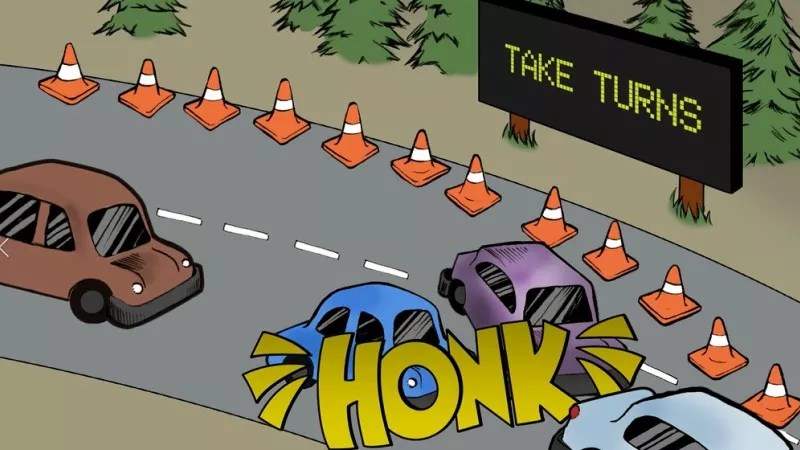

Audio By Carbonatix
During the year I lived in greater Chicago, every highway in the city seemed to be under construction, resulting in frequent lane closures and merges that were often indistinguishable from total gridlock. Typically, the continuing lane would be incredibly backed up, often for a mile or more, as everyone joined at the end of the line even though the one next to it would be wide open up until the blockage. So at a certain point, I started moving into the vacated lane and squeezing in at the merge point, which tended to anger other drivers sitting bumper-to-bumper but proved to be a huge time-saver. That’s why I began referring to this technique as “using the Asshole Lane.”
In the nearly three decades I’ve been back in Colorado, I’ve continued to deploy the Asshole Lane tactic, much to the displeasure of some motorists. A few months ago, for instance, a giant pickup came within inches of hitting my 1990s-vintage Honda Accord because the pissed-off driver decided to teach me a lesson.
Now it’s time for him to be schooled. Turns out the Colorado Department of Transportation wants us to drive in the Asshole Lane for as long as possible. Of course, CDOT’s terminology is much more benign – the agency calls it either “late merge” or “zipper merge” – but the idea is exactly the same. Now it’s just a matter of convincing drivers that such merges are appropriate and preferable rather than an extreme example of automotive impoliteness.
“We need to help folks understand that safety is the key, and this helps keep us safer,” says Lisa Schwantes, one of the department’s regional communications managers.
This year, make your gift count –
Invest in local news that matters.
Our work is funded by readers like you who make voluntary gifts because they value our work and want to see it continue. Make a contribution today to help us reach our $50,000 goal!
It’s been a tough sell. Schwantes admits that “the zipper merge or late merge concept is something we’ve been trying to promote for many years now,” as evidenced by the following video, issued by CDOT in 2016.
CDOT loves the late/zipper merge because “it’s a much more efficient way of keeping traffic moving,” Schwantes allows. “It reduces the queue of traffic, that stacking of vehicles in one lane, by utilizing the most lanes we possibly can until the merge point.” The concept is “to stay in your lane until you reach that merge point and then take turns getting into the one lane that’s being caused by either a construction project or a crash.”
Many commuters may instinctively object to this approach because of long-ago mixed messages, Schwantes believes. “We’re taught at a very young age, usually in kindergarten or grade school, not to take cuts in line. But we also learn when we’re young to take turns, and that’s all this is. It’s just a matter of realizing that we’re trying to keep traffic moving as smoothly and efficiently for as long as we can. And this kind of merge will decrease the chances of a secondary crash because of stopped traffic. When you’re utilizing only one lane and folks are starting to merge early and you start getting that long queue of traffic, that increases the possibility of a secondary crash, because traffic is stopped. When traffic is moving smoothly, there’s less of a likelihood for a crash to occur.”
To get this message across, CDOT is ramping up its use of social media and other methods of communication about such merges. But the department is also committed to increasing the use of signage at construction sites where a lane is closed to inspire behavior changes in real time.
Schwantes knows from personal experience that this methodology works – but it can take a while. “I work in the southwest corner of the state, and there was a two-season project in downtown Durango that really disrupted traffic. So we really tried to promote the zipper merge, the late merge. We had a lot of signage up to help get folks to use both lanes to the merge point: electronic message boards as well as static signs. And eventually, we got drivers to use both lanes up to that point.”
Unfortunately, few of them retained that knowledge, she concedes. “That project ended a year and a half or two years ago, and now we have a new project downtown. But folks don’t know how to zipper merge, so we’re having to re-educate them. We’re pushing the late merge concept through newspapers, radio stations and signage in project-work zones. We’re definitely creatures of habit, and we just need to learn this new concept.”
In the meantime, Schwantes encourages drivers who know better to risk the wrath of their fellow motorists and merge the smarter way. “You may feel you need to merge early because that’s what everybody else is doing. But maybe you should take that leap of faith and stay in the lane and go up to the merge point – and other folks will follow you. If folks pay attention and pay heed to the signage, and we’re telling you to stay in both lanes, then stay in both lanes. That’s what we’re encouraging you to do. You aren’t being rude.”
Guess I’m not an asshole after all.